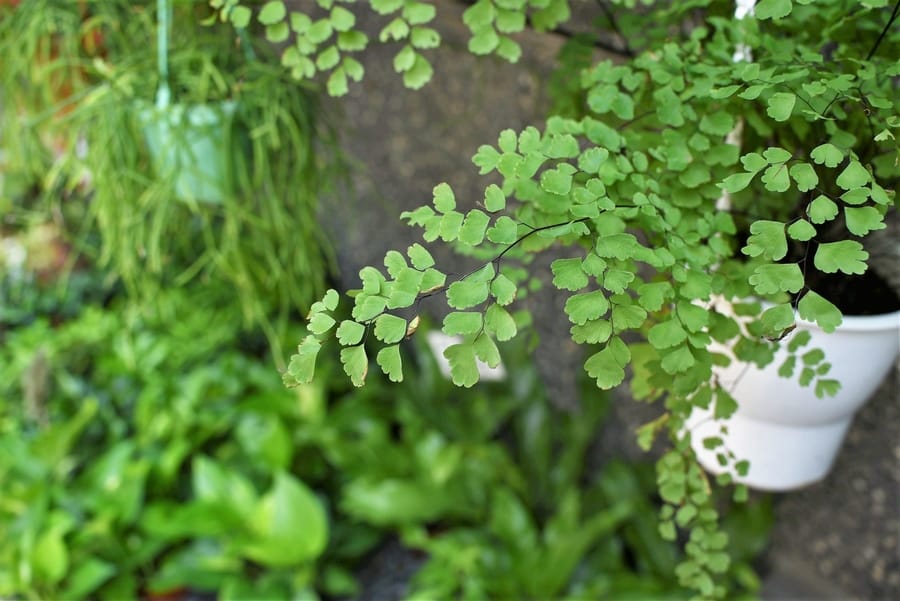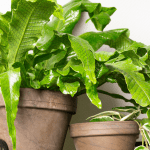
We recently bought a nearly dead maidenhair fern from a garage sale. We researched every possible solution to save this beautiful houseplant. We found out why these plants don’t survive in certain conditions and brought ours back to life.
So, why is your maidenhair fern dying? Too much sunlight, temperatures above 75 or below 60 degrees F, low humidity, inconsistent moisture, over-fertilization and overcrowding are the major culprits. Ferns need indirect sunlight, moist soil, high humidity, and moderate temperatures to thrive.
Many new maidenhair fern owners don’t fully understand the requirements of this resilient but delicate plant. In this article, we’ll address common problems and provide solutions for a shriveled, brown, or otherwise unwell Adiantum.
Too Much Sunlight
Maidenhair ferns are native to damp, shady woods and forests. Leaves will scald and wilt if they’re exposed to intense, direct sunlight. If your fern lives in a south- or west-facing window, it’s getting too much light.
SOLUTION: Move to a north-facing window for the ideal amount of light. In the winter months, maidenhair ferns may tolerate an east-facing window. If you don’t want to move your plant halfway through the year, place it in a north-facing window with plenty of indirect sunlight for the best results.
Incorrect Temperatures
As with most ferns, maidenhair requires moderate temperatures. The ideal growing temperature is between 65 degrees and 75 degrees F during the day. Nighttime temperatures should not drop below 55 degrees F.
If your fern is in a sun-room or other area of the home that gets too hot during the day, this can damage the plant’s delicate leaves and cause the fronds to brown.
SOLUTION: Move maidenhair fern to a cooler area (but not too cool). Place an outdoor thermometer near the plant and check during the hottest part of the day. If the reading is above 75 degrees, the area is too hot. When you leave home for more than a few hours, make sure to keep your thermostat set between 65 and 75 degrees.
Not Enough Humidity
Maidenhair ferns need high humidity to survive. For this reason, they thrive in bathrooms if the temperature and lighting is adequate. Indoor ferns require a humidity level of 30 to 50 percent, with 30 percent being about the lowest they can tolerate. Forty to 50 percent produces the best environment.
If you live in a dry climate and/or use forced air (also known as central heat and air) to heat and cool your home, the air may be too dry for a fern to thrive.
SOLUTION: Add a humidifier to your home – either built into your heating system or a self-contained unit. If purchasing a humidifier isn’t an option right now, place the pot on a tray filled with pebbles and water. Make sure to keep the water level below the pebbles so the pot is never standing in water. Also, wash and replace the pebbles regularly – about every three months – to prevent algae from growing.
See my post on how to make a humidity tray if you’re not familiar with the process.
During the winter months, mist ferns lightly with a plant mister or plastic spray bottle that has a fine mist setting. This is especially important if you use forced air to heat your home. Use room temperature water so you don’t shock the plant.
In our house, we prefer using a humidity tray AND a humidifier – especially since we live in a very arid climate. You can still grow ferns indoors, even in the desert, if you keep the conditions in your home hospitable. A humidifier creates a more comfortable environment for all your houseplants (and your family).
Click here to check out our favorite humidifier for houseplants on Amazon. It’s relatively inexpensive, keeps indoor air at 40 – 60 percent humidity (perfect for ferns), runs quietly, and is very easy to clean. We keep it in our living room where most of our ferns live.
Inconsistent Moisture
Keeping the soil moist but not wet is the key to making maidenhair fern happy. Watering too often causes the lacy fronds to yellow and wilt. Wet soil will eventually lead to root rot or other fungal diseases. Not watering often enough also causes the leaves to wilt.
Watering your houseplants – especially ferns – is more of an art than a science. You’ll have to develop a feel for the soil to get it right. As a rule of thumb, if the soil is dry to the touch, it needs water.
SOLUTION: Never allow the soil of your maidenhair ferns to dry out completely. Consistent moisture is key. Check the soil every day and add more water if it feels dry. You may need to water more heavily during the growing season and less frequently during the winter months.
If maidenhair dries out, the leaves may shrivel and die completely. Unlike many other houseplants, the fronds will not perk up again after being watered. But don’t give up! If you continue watering regularly – without watering too much – new shoots will appear.
Over Fertilization
Too much fertilizer will scorch delicate maidenhair fern foliage. In general, ferns only need very light fertilization during the growing season, and newly potted plants don’t need to be fertilized for four to six months, or until active signs of growth are observed.
If you’ve been fertilizing too much, leaves can turn brown and drop off. Your entire plant can even die, so keep a light touch when feeding. If you haven’t been feeding enough, your plant may be starving and in need of nutrients.
SOLUTION: Only feed Maidenhair ferns once a month with liquid houseplant fertilizer at ½ strength during April through September. This provides essential nutrients without overfeeding and scorching. If your plant is still actively growing during the winter months, continue feeding. Otherwise, hold off until active growth is seen again int the spring.
Overcrowding
Maidenhair ferns need to be repotted every couple of years and will fail to thrive if they become too crowded in their current pot. If necessary, divide them by cutting between the fleshy roots known as rhizomes, keeping as many leaves as possible on each division.
How can you tell if your fern is overcrowded? Look for these signs:
- The plant completely fills the pot it is growing in.
- Roots are growing out of drainage holes or over the sides of the pot.
- Roots are growing out of the top of the soil or crowding out the soil.
- Water runs right through the pot and out of the drain hole instead of soaking into the soil.
SOLUTION: If you suspect your ferns are overcrowded, move them to a bigger pot or divide them in the spring just before new growth begins. For the best results, use a potting mix that contains 50 percent peat moss. Maidenhair likes a tablespoon of ground limestone mixed in per gallon of potting mixture.
Related Questions
How do you save an overwatered fern? When overwatered, a fern will rot and die quickly. STOP watering immediately. Allow the soil to almost dry out, and then begin a proper watering schedule. Start by watering once a week. Check the soil daily and increase frequency if it dries out between waterings.
Remember, it’s easier to save a dried-out fern than an overwatered one. Be cautious when you’re just beginning to get a feel for watering a new plant.
Why are my maidenhair fern leaves turning brown? The most common cause of brown leaves in ferns is low humidity. This means the air around the plant is too dry. Use a humidifier near the plant to keep the humidity around 40 – 60 percent or place the pot on a tray filled with pebbles and water to increase moisture in the air.
Another possible cause is too much fertilizer. See the section on over fertilization above for tips on feeding your maidenhair ferns properly without scorching.
See Also: Maidenhair Fern Indoor Plant Care Guide





